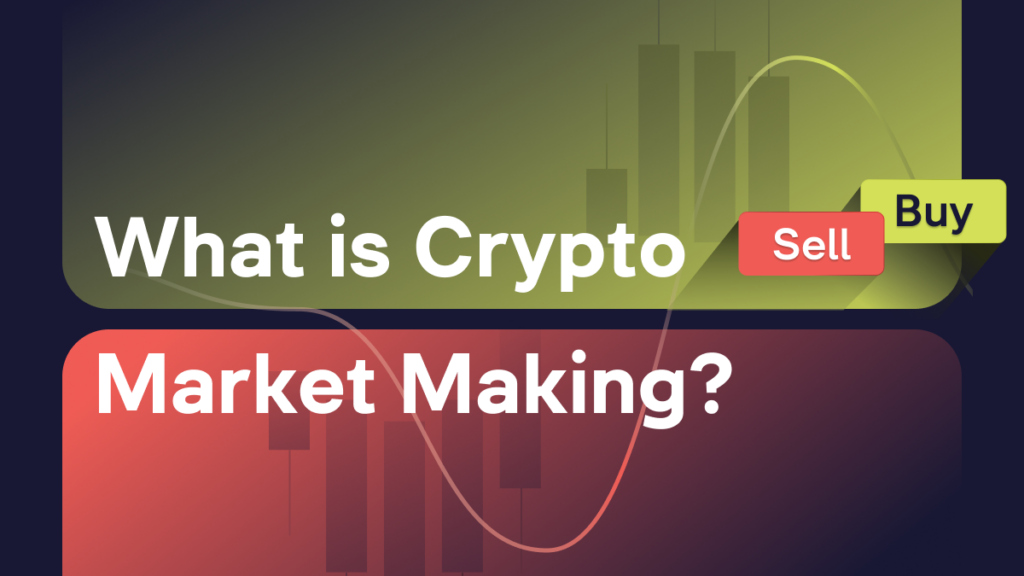What Is Crypto Market Making, and Who Are the Market Makers?

Content
Cryptocurrency trading involves multiple players, ensuring its day-to-day operation. One of its critical parts is market makers (MMs), which provide smooth operations and liquidity. In this article, we will explore the concept of crypto market making, explain who are the market makers in crypto, why they are essential, examine their strategies, and discuss the risks and challenges they face.
What Is the Market Making in Crypto?
The concept refers to providing liquidity to cryptocurrency markets by actively buying and selling digital assets. Market makers act as intermediaries, constantly offering bids and asks prices to facilitate trading. Their presence maintains market stability and allows traders to execute transactions efficiently, even in markets with limited liquidity.
WhiteBIT Market Making Program
WhiteBIT is one of the largest cryptocurrency exchanges in Europe, which provides access to more than 350 trading pairs and 24 markets exclusively for trading futures to over 4M users worldwide. The average daily trading volume exceeds half a billion USD for spot and futures markets.
What Is a Market Maker Crypto On WhiteBIT?
WhiteBIT provides an easy solution for market makers to enhance their trading activity effectively:
- Collocation services to place your trading infrastructure close to our matching engine. Reduce the network latency to execute trades with lightning-fast speed and gain a competitive edge in the market.
- Subaccounts to segregate trading activities, funds, and positions. You can effectively manage multiple strategies or client relationships with enhanced control and transparency, optimizing risk management and capital allocation.
- Flexible API to enable seamless integration of trading algorithms and systems. With our API, you can automate trading strategies, access real-time market data, and execute trades effortlessly.
- VIP support to provide personalized assistance, quickly address your queries, and ensure a smooth and efficient trading experience.
There are attractive rebates, reasonable entry requirements, and personal rewards for the best market makers.
The minimum entry requirement for spot market makers is $100M maker volume for the past 30 days.
Rebates for spot market makers can reach up to -0.010% maker’s fee and 0.02% taker’s fee, depending on the monthly trading volume.
The minimum entry requirement to trade futures as a market maker is ≥2% maker volume of total volume on WhiteBIT’s Futures platform for the past 30 days (at least $30M).
Rebates for futures market makers can reach up to -0.02% maker’s fee and up to 0.032% taker’s fee, depending on the monthly trading volume.
How to Become a Market Maker on WhiteBIT?
All you have to do is complete the following 3 steps:
- Negotiate the best possible terms, allowing to earn a sufficient margin. Our manager will reach out to you to agree on the terms of the Market Making program.
- Onboarding. Sign up for the WhiteBIT crypto exchange, pass the KYB verification, confirm your trading volumes, and perform technical integration.
- Start trading and grow your volumes to get even better terms.
Fill out the form to take the first step to trade on more favorable terms now.
What Is a Market Maker in Crypto, and Why Are They Needed?
The need for crypto market making services arises due to factors inherent to the cryptocurrency ecosystem. Cryptocurrencies operate in a decentralized environment, resulting in fragmented order books and relatively lower trading volumes compared to traditional financial markets. This fragmentation can lead to price inefficiencies and limited liquidity, making it challenging for traders to execute trades promptly. MMs bridge this gap by providing continuous liquidity, reducing spreads, and minimizing price slippage.
How Do Crypto Market Makers Work?
They employ sophisticated strategies and algorithms to fulfill their role and closely monitor market conditions, including trading volume, price movements, and market sentiment. Based on this analysis, MMs adjust their bid and ask prices to ensure a balanced book and attract buyers and sellers. They generate profits by fixing the bid-ask spread while enhancing market efficiency and stability.
Who is the market maker in crypto? It can be both human traders and automated software systems. The former manually analyze market trends, assess supply and demand dynamics, and execute trades based on their judgment. They use their expertise to adjust trading strategies based on market conditions, news, and other relevant factors.
Unlike traditional centralized exchanges (CEX), decentralized exchanges (DEX) usually use automated market maker crypto (AMMs). These decentralized protocols leverage smart contracts to automatically provide liquidity for trading pairs without the need for traditional order books.
A crypto market maker bot can also play a role of an intermediary between buyers and sellers, actively managing order books and providing liquidity. While it is also an automated MM service, a bot is based on a different algorithm. It calculates bids and asks prices based on various market factors, such as supply and demand dynamics, market trends, and order book depth. A bot typically operates as an individual entity, often developed and controlled by a single user or organization.
Crypto Market Making Strategies
MMs utilize various strategies to fulfill their role effectively. Two common strategies include passive market making and statistical market making:
- Passive crypto market making strategy: Market makers place limit orders at specific price levels and wait for other traders to execute trades against their orders. They earn profits from the bid-ask spread while avoiding excessive risk exposure.
- Statistical market making: This strategy involves analyzing historical trading data and market trends to predict price movements. Market makers use statistical models and algorithms to adjust their quotes dynamically, aligning them with market conditions.
- High-frequency trading (HFT) market making uses advanced algorithms and technology to execute a large number of trades at high speeds. Its purpose is to provide liquidity to the market by constantly buying and selling crypto. The strategy relies on algorithms and computing systems to identify and exploit short-term crypto price discrepancies, profiting from small price differences.
- Inter-exchange arbitration is a strategy used to capitalize on price variations for the same digital currency across different exchanges. Traders buy the cryptocurrency at a lower price on one exchange and swiftly sell it at a higher price on another exchange.
Key Risks and Hurdles of Crypto Market Making
Crypto market making comes with its own set of risks and challenges:
- Market volatility. Significant price movements can expose market makers to potential losses.
- Liquidity risk is a concern for less liquid or newly launched cryptocurrencies. MMs may face difficulties efficiently matching buy and sell orders because of limited trading activity.
- Regulatory risks can lead to limitations.
- Technical failures, such as connectivity issues or glitches in trading algorithms, can disrupt market making activities.
- Market maker manipulation crypto. Unscrupulous actors use practices like spoofing, wash trading, and front running to manipulate prices and deceive other market participants. This manipulation can lead to false market signals and negatively impact traders and investors.
Final Word
Crypto market making is vital in cryptocurrency, ensuring liquidity, stability, and efficient trading. Entities that are crypto market makers, whether human or automated systems, bridge liquidity gaps, maintain balanced order books, and narrow bid-ask spreads.
However, market makers also face risks and challenges such as market volatility, liquidity limitations, regulatory uncertainty, technological issues, and the potential for market makers’ manipulation. Despite these challenges, they remain essential participants in the crypto market, facilitating smooth operations and contributing to the overall growth and development of the ecosystem.









